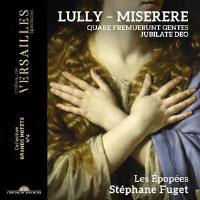Texte paru dans: / Appeared in:
Château de Versailles |
|
|
Outil de traduction ~ (Très approximatif) |
|
|
Reviewer: Bertil
van Boer
In a continuation of the recording of the sacred music at the court of Louis XIV, the Chateau de Versailles label has issued this second volume entitled Grand Motets. This features three more of the large-scale works by Jean-Baptiste Lully, whose job as the chief musical composer at court included writing such pieces to celebrate propitious occasions. Usually, Lully left the everyday composition of sacred works to others, but his position required him to compose the most spectacular pieces for state occasions. These three works represent such events. The earliest is the Jubilate Deo, which in 1660 had a twofold purpose, to celebrate Louis’s wedding to Maria Theresa, daughter of Philip V of Spain, and the Treaty of the Pyrenees, which both concluded the war with Spain and created the dynastic marriage between the two European powers. The fact that France, for once, emerged dominant politically argued for a spectacular celebratory event, for which the motet was well suited. The Miserere was written for a less auspicious event, the 1663 Lenten season, for which the composer was to create sacred music fit for the royal court but in keeping with the solemnity of the season. It was such a success that it became his best-known work, serving numerous times as music for the funerals of important figures in France. Indeed, it was so popular that in 1684 the King allowed it to be published, and even today it is one of Lully’s most performed and recorded works. The motet Quare fremuerunt gentes dates from towards the end of the composer’s life. Originally written for the services of Holy Week in 1685, it too served a dual purpose. First, Lully’s position with the King was slowly eroding as he came under the moralist spell of his new queen. The composer’s own reputation was solidly rotten due to a profligate lifestyle, and so he probably feared that her pietist influence would be detrimental to his own position. Second, though, the previous year France had signed the Peace Treaty of Regensburg, ending yet another war, this time between the combined forces of Spain (now that the former queen had died), Denmark, the Holy Roman Empire of the German Nation, and the United Provinces that included both Germany and the Netherlands. The motet itself is generally quite bellicose, which makes it an odd celebratory work for a peace treaty, but here the Imperial message to the warring parties was the overriding message: Be at peace, but know the power of the French king. The Miserere is perhaps one of the best known of his sacred works. It is richly scored for a multitude of strings, accompanied by the Écurie of oboes and bassoons. The opening number unfolds slowly and solemnly with close harmonies and juxtapositions of soloists and full chorus. It is entirely reflective in tone, even penitential. New orchestral and vocal colors emerge at virtually every turn. In the Tibi soli, for example, the violins have some challenging ornaments at the opening, but then after the soloists enter, the chorus erupts with a frenetic homophonic passage. The Auditui meo dabis has a delightful and quite lyrical duet between the soprano soloists, while the Cor mundum opens with close suspensions that lead directly into a sort of tenor recitative-arioso before returning to the close harmonies at the end. The Docebo is quite declamatory, almost Handelian in its modernity, and the work ends with a rather bouncy rhythmic Ut ædificentur, with the chorus divided and quite imitative. The Quare fremerunt gentes begins with a rather arrogant bass solo and swirling string accompaniment, and then there is a chorus that is declamatory. This tone continues until the Ego autem, which is more solemn and reflective, with slowly interweaving violin parts and a lovely lyrical vocal part for the soloists. Elsewhere, the vocal lines tend towards the florid, but here they float along easily. The final Beati omnes is a chant-like prayer, concluding the work on a more serious tone. The same restrained mood is at work in the Jubilate Deo, where Lully opts for a pensive hymn of jubilation. The Regis terræ has a soft recitative accompanied only by the mid-range strings (here, violas divided according to register). The Arcum conterit for solo bass contrasts with its dance rhythms, while the Jubilate in conspectus regis is a homophonic chorale leading to the final movement (Orta est enim) with its crossing solo lines and final hymn for the chorus. All in all, these works are masterpieces of dramatic reflection, and they demonstrate that Lully, for all his personal foibles, was a consummate composer of sacred music. As always, the Chateau de Versailles label has offered a thoughtful, excellently performed continuation of the Grand Motets series (this being the fourth volume). Conductor Stéphane Fuget has a highly disciplined ensemble that brings out the depth and intricate layers of Lully’s music with fine diction (for the vocalists) and tempos that highlight the dramatic content. Too often, this sort of music can be static, which does it no favors. Here, however, the performance is engaging and powerful, showing the pride and elegance of the French court of Louis XIV. This is one excellent disc and should be part of any collection. Better yet, get the entire series, past, present, and future.
| |
|
|
|
|
|
|
|
Cliquez l'un ou l'autre
bouton pour découvrir bien d'autres critiques de CD |
|




